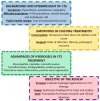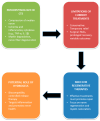Hydrogel-Based Innovations in Carpal Tunnel Syndrome: Bridging Pathophysiological Complexities and Translational Therapeutic Gaps
- PMID: 39852023
- PMCID: PMC11764971
- DOI: 10.3390/gels11010052
Hydrogel-Based Innovations in Carpal Tunnel Syndrome: Bridging Pathophysiological Complexities and Translational Therapeutic Gaps
Abstract
Carpal Tunnel Syndrome (CTS) is a prevalent neuropathic disorder caused by chronic compression of the median nerve, leading to sensory and motor impairments. Conventional treatments, such as corticosteroid injections, wrist splinting, and surgical decompression, often fail to provide adequate outcomes for chronic or recurrent cases, emphasizing the need for innovative therapies. Hydrogels, highly biocompatible three-dimensional biomaterials with customizable properties, hold significant potential for CTS management. Their ability to mimic the extracellular matrix facilitates localized drug delivery, anti-adhesion barrier formation, and tissue regeneration. Advances in hydrogel engineering have introduced stimuli-responsive systems tailored to the biomechanical environment of the carpal tunnel, enabling sustained therapeutic release and improved tissue integration. Despite these promising developments, hydrogel applications for CTS remain underexplored. Key challenges include the absence of CTS-specific preclinical models and the need for rigorous clinical validation. Addressing these gaps could unlock the full potential of hydrogel-based interventions, which offer minimally invasive, customizable solutions that could improve long-term outcomes and reduce recurrence rates. This review highlights hydrogels as a transformative approach to CTS therapy, advocating for continued research to address translational barriers. These innovations have the potential to redefine the treatment landscape, significantly enhancing patient care and quality of life.
Keywords: CTS therapy; biomaterials; carpal tunnel syndrome; functional hydrogels; hydrogels; peripheral nerve injury.
Conflict of interest statement
The authors declare no conflicts of interest.
Figures
References
-
- Rotaru-Zavaleanu A.D., Lungulescu C.V., Bunescu M.G., Vasile R.C., Gheorman V., Gresita A., Dinescu V.C. Occupational Carpal Tunnel Syndrome: A scoping review of causes, mechanisms, diagnosis, and intervention strategies. Front. Public Health. 2024;12:1407302. doi: 10.3389/fpubh.2024.1407302. - DOI - PMC - PubMed
Publication types
LinkOut - more resources
Full Text Sources
Research Materials




